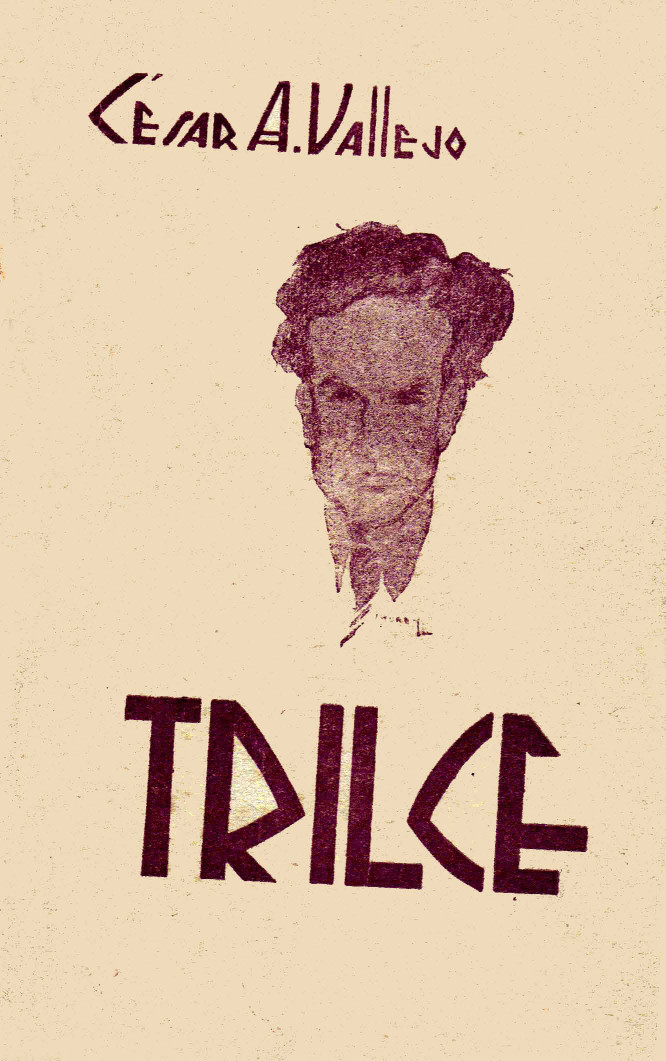César Vallejo: Trilce (1922–) [Spanish, English]
Filed under poetry | Tags: · avant-garde, language, poetry

Trilce is the second and the most well-known book of poetry by the Peruvian author César Vallejo.
Pared of all ornamental language, Trilce introduces the wrenched syntax that allows Vallejo to get beyond the constraints of received linguistic conventions. Writing in A History of Peruvian Literature, James Higgins catalogues the elements of Vallejo’s diction: “Vallejo confounds the reader’s expectations by his daring exploitation of the line pause, which often leaves articles, conjunctions and even particles of words dangling at the end of a line, by his frequent resort to harsh sounds to break the rhythm, by employing alliterations so awkward as to be tongue-twisters. He distorts syntactic structures, changes the grammatical function of words, plays with spelling. His poetic vocabulary is frequently unfamiliar and ‘unliterary,’ he creates new words of his own, he often conflates two words into one, he tampers with cliches to give them new meaning, he plays on the multiple meaning of words and on the similarity of sound between words. He repeatedly makes use of oxymoron and paradox and, above all, catachresis, defamiliarising objects by attributing to them qualities not normally associated with them.”
D. P. Gallagher suggests in Modern Latin American Literature that Vallejo was “perhaps the first Latin American writer to have realized that it is precisely in the discovery of a language where literature must find itself in a continent where for centuries the written word was notorious more for what it concealed than for what it revealed, where ‘beautiful’ writing, sheer sonorous wordiness was a mere holding operation against the fact that you did not dare really say anything at all.” (from Vallejo’s biography by Poetry Foundation)
With a Foreword by Antenor Orrego
Publisher Talleres tipográficos de la Penitenciaría, Lima, 1922
136 pages
via Biblioteca BBVA
Commentary (Michelle Clayton, Poetry in Pieces: César Vallejo and Lyric Modernity, 2011, 329 pp)
Wikipedia (ES)
Wikipedia (EN)
PDF (Spanish), other editions: 1961, 1982, 1986, 1987
HTML (Spanish/English, trans. Clayton Eshleman, 2007)
Pierre Schaeffer: In Search of a Concrete Music (1952/2012)
Filed under book | Tags: · composition, electroacoustic music, media, music, music theory, musique concrète, sound

“Pierre Schaeffer’s In Search of a Concrete Music has long been considered a classic text in electroacoustic music and sound recording. Now Schaeffer’s pioneering work—at once a journal of his experiments in sound composition and a treatise on the raison d’être of “concrete music”—is available for the first time in English translation. Schaeffer’s theories have had a profound influence on composers working with technology. However, they extend beyond the confines of the studio and are applicable to many areas of contemporary musical thought, such as defining an ‘instrument’ and classifying sounds. Schaeffer has also become increasingly relevant to DJs and hip-hop producers as well as sound-based media artists. This unique book is essential for anyone interested in contemporary musicology or media history.”
First published as À la recherche d’une musique concrète, Seuil, Paris, 1952.
Translated by Christine North and John Dack
Publisher University of California Press, 2012
ISBN 0520265742, 9780520265745
225 pages
Reviews: Daniela Cascella (Los Angeles Review of Books, 2013), Brian Kane (Organised Sound, 2013), Warren Burt (SoundBytes, 2014).
PDF, PDF (7 MB, updated to an OCR’d version via Marcell Mars)
More from Schaeffer on Monoskop wiki (writings), UbuWeb (recordings), and Artsonores (films).
Comments (2)Alfred Gell: Art and Agency: An Anthropological Theory (1998)
Filed under book | Tags: · aesthetics, agency, anthropology, art, art theory, causality, image, representation, style, tattoo

“Alfred Gell puts forward an anthropological theory of visual art seen as a form of instrumental action: the making of things as a means of influencing the thoughts and actions of others. He argues that existing anthropological and aesthetic theories take an overwhelmingly passive point of view, and questions the criteria that accord art status only to a certain class of objects and not to others. The anthropology of art is here reformulated as the anthropology of a category of action: Gell shows how art objects embody complex intentionalities and mediate social agency. He explores the psychology of patterns and perceptions, art and personhood, the control of knowledge, and the interpretation of meaning, drawing upon a diversity of artistic traditions-European, Indian, Polynesian, Melanesian, and Australian.”
With a Foreword by Nicholas Thomas
Publisher Clarendon Press, Oxford, 1998
ISBN 0198280149, 9780198280149
272 pages
via mrcds
Reviews: Michèle Coquet (L’Homme, 2001, FR), Kate Sharpe (European Journal of Archaeology, 2004), Jan Willem Noldus (Histara, 2009, FR), Gilles Bastin (Le Monde, 2009, FR), Christophe Domino (Le Journal des arts, 2009, FR), Pierre Charbonnier (Tina, 2010, FR), Marcel Alocco (PerformArts, 2010, FR), Agnès Giard (Libération, 2014, FR), Mylene Mizrahi (Proa, 2019, PT).
Critical analyses: Maurice Bloch (Terrain, 1999, FR), Robert Layton (Journal of the Royal Anthropological Institute, 2003), Ross Bowden (Oceania, 2004), Howard Morphy (Journal of Material Culture, 2009), Brigitte Derlon and Monique Jeudy-Ballini (Oceania, 2010).
PDF (68 MB, updated on 2020-6-4)
EPUB (4 MB, added on 2014-9-14 via Marcell)

